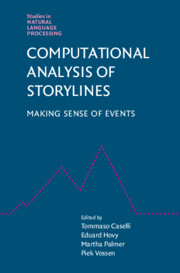22 results
List of Contributors
-
- Book:
- Computational Analysis of Storylines
- Published online:
- 06 November 2021
- Print publication:
- 25 November 2021, pp xi-xiv
-
- Chapter
- Export citation
3 - Decomposing Events and Storylines
- from Part One - Foundational Components of Storylines
-
- Book:
- Computational Analysis of Storylines
- Published online:
- 06 November 2021
- Print publication:
- 25 November 2021, pp 67-86
-
- Chapter
- Export citation
1 - The Role of Event-Based Representations and Reasoning in Language
- from Part One - Foundational Components of Storylines
-
- Book:
- Computational Analysis of Storylines
- Published online:
- 06 November 2021
- Print publication:
- 25 November 2021, pp 23-46
-
- Chapter
- Export citation
Part One - Foundational Components of Storylines
-
- Book:
- Computational Analysis of Storylines
- Published online:
- 06 November 2021
- Print publication:
- 25 November 2021, pp 21-22
-
- Chapter
- Export citation
4 - Extracting and Aligning Timelines
- from Part One - Foundational Components of Storylines
-
- Book:
- Computational Analysis of Storylines
- Published online:
- 06 November 2021
- Print publication:
- 25 November 2021, pp 87-105
-
- Chapter
- Export citation
8 - Low-Resource Event Extraction via Share-and-Transfer and Remaining Challenges
- from Part Two - Connecting the Dots: Resources, Tools, and Representations
-
- Book:
- Computational Analysis of Storylines
- Published online:
- 06 November 2021
- Print publication:
- 25 November 2021, pp 163-186
-
- Chapter
- Export citation
11 - Exploring Machine Learning Techniques for Linking Event Templates
- from Part Two - Connecting the Dots: Resources, Tools, and Representations
-
- Book:
- Computational Analysis of Storylines
- Published online:
- 06 November 2021
- Print publication:
- 25 November 2021, pp 221-239
-
- Chapter
- Export citation
9 - Reading Certainty across Sources
- from Part Two - Connecting the Dots: Resources, Tools, and Representations
-
- Book:
- Computational Analysis of Storylines
- Published online:
- 06 November 2021
- Print publication:
- 25 November 2021, pp 187-202
-
- Chapter
- Export citation
Part Two - Connecting the Dots: Resources, Tools, and Representations
-
- Book:
- Computational Analysis of Storylines
- Published online:
- 06 November 2021
- Print publication:
- 25 November 2021, pp 143-144
-
- Chapter
- Export citation
6 - A Narratology-Based Framework for Storyline Extraction
- from Part One - Foundational Components of Storylines
-
- Book:
- Computational Analysis of Storylines
- Published online:
- 06 November 2021
- Print publication:
- 25 November 2021, pp 125-142
-
- Chapter
- Export citation
Frontmatter
-
- Book:
- Computational Analysis of Storylines
- Published online:
- 06 November 2021
- Print publication:
- 25 November 2021, pp i-vi
-
- Chapter
- Export citation
7 - The Richer Event Description Corpus for Event–Event Relations
- from Part Two - Connecting the Dots: Resources, Tools, and Representations
-
- Book:
- Computational Analysis of Storylines
- Published online:
- 06 November 2021
- Print publication:
- 25 November 2021, pp 145-162
-
- Chapter
- Export citation
12 - Semantic Storytelling: From Experiments and Prototypes to a Technical Solution
- from Part Two - Connecting the Dots: Resources, Tools, and Representations
-
- Book:
- Computational Analysis of Storylines
- Published online:
- 06 November 2021
- Print publication:
- 25 November 2021, pp 240-259
-
- Chapter
- Export citation
5 - Event Causality
- from Part One - Foundational Components of Storylines
-
- Book:
- Computational Analysis of Storylines
- Published online:
- 06 November 2021
- Print publication:
- 25 November 2021, pp 106-124
-
- Chapter
- Export citation
2 - The Rich Event Ontology: Ontological Hub for Event Representations
- from Part One - Foundational Components of Storylines
-
- Book:
- Computational Analysis of Storylines
- Published online:
- 06 November 2021
- Print publication:
- 25 November 2021, pp 47-66
-
- Chapter
- Export citation
Introduction and Overview
-
- Book:
- Computational Analysis of Storylines
- Published online:
- 06 November 2021
- Print publication:
- 25 November 2021, pp 1-20
-
- Chapter
- Export citation
Author Index
-
- Book:
- Computational Analysis of Storylines
- Published online:
- 06 November 2021
- Print publication:
- 25 November 2021, pp 260-260
-
- Chapter
- Export citation
10 - Narrative Homogeneity and Heterogeneity in Document Categories
- from Part Two - Connecting the Dots: Resources, Tools, and Representations
-
- Book:
- Computational Analysis of Storylines
- Published online:
- 06 November 2021
- Print publication:
- 25 November 2021, pp 203-220
-
- Chapter
- Export citation
Contents
-
- Book:
- Computational Analysis of Storylines
- Published online:
- 06 November 2021
- Print publication:
- 25 November 2021, pp vii-x
-
- Chapter
- Export citation

Computational Analysis of Storylines
- Making Sense of Events
-
- Published online:
- 06 November 2021
- Print publication:
- 25 November 2021

